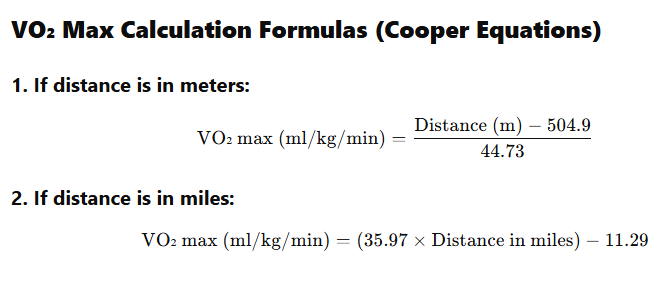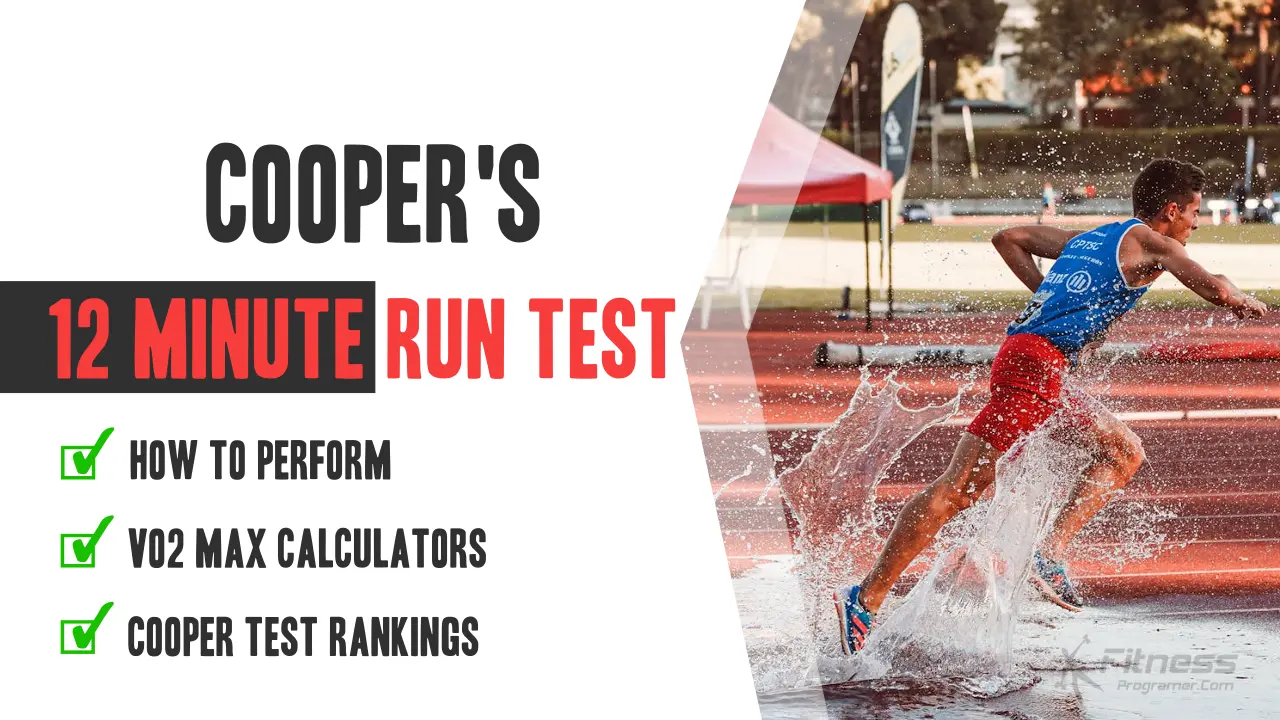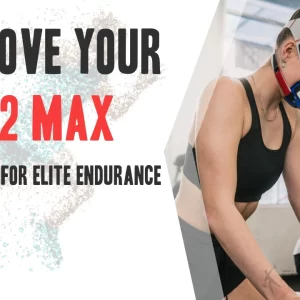Contents
- What is the 12 Minute Run Test?
- Physiological Basis of the Cooper Test
- How to Perform the 12-Minute Run Test
- Cooper Test Performance Rankings
- How to Calculate VO₂ Max with the 12-Min Cooper Test
- Cooper Test Calculator
- VO₂ Max & Cooper Test Ranking
- Normative VO₂ Max Values by Age and Gender
- Benefits of the Cooper Test
- Limitations of the Cooper Test
- Training Implications
- Who Should Use the Cooper Test?
- Alternatives to the Cooper Test
- Conclusion
VO₂ max, or maximal oxygen uptake, is the most widely accepted indicator of cardiorespiratory endurance. It represents the body’s capacity to deliver and utilize oxygen during sustained physical activity. VO₂ max is strongly correlated with athletic performance, health outcomes, and longevity. However, direct measurement requires expensive equipment and laboratory conditions.
Enter the Cooper Test—a time-efficient and evidence-based field method for estimating VO₂ max without lab equipment.
Hello, I’m Alexandra Botez from the Fitnessprogramer.com team. I’ve carefully prepared this article to help you understand the 12-minute run test and improve your VO₂ max. And don’t worry, my future articles are designed to keep you engaged, not out of breath!
What is the 12 Minute Run Test?
The 12-minute Cooper run test is a simple, yet highly effective method for assessing an individual’s cardiorespiratory endurance and aerobic fitness. The test involves running as far as possible in exactly 12 minutes. The total distance covered during this time is then used to estimate the individual’s VO₂ max.
Developed in 1968 by Dr. Kenneth H. Cooper, a physician and former U.S. Air Force Colonel, this test was originally designed to evaluate the aerobic capacity of military personnel. Its practicality, minimal equipment requirement, and high correlation with VO₂ max made it a widely adopted tool in both military and civilian settings.
Dr. Cooper’s vision was to create a simple, evidence-based fitness tool for large populations—and more than 50 years later, the test remains a gold standard in endurance evaluation worldwide.
“This test provides a practical method for estimating maximal oxygen intake and physical performance.” — Cooper KH, JAMA, 1968
Physiological Basis of the Cooper Test
During the 12-minute run test, individuals run at their maximum sustainable pace. This submaximal-to-maximal effort reflects:
- Aerobic power (VO₂ max)
- Cardiovascular Endurance
- Cardiopulmonary efficiency
- Lactate threshold proximity
- Running economy (to a lesser extent)
The total distance run in 12 minutes is a proxy for aerobic energy system capacity, as longer distances reflect better oxygen utilization over time. Although not the test’s main goal, it also provides insight into your ability to pace over time, which is an essential skill in endurance training and racing. Covering more distance in 12 minutes requires a balance of stamina, mental focus, and efficient energy use.
How to Perform the 12-Minute Run Test
- Warm up for 5–10 minutes with light jogging and dynamic mobility drills.
- Start the stopwatch and run continuously for 12 minutes at the fastest sustainable pace.
- Stop when the 12 minutes are up.
- Measure or record the exact distance covered.
- Cool down for 5–10 minutes after the test.
- Use the appropriate Cooper VO₂ max formula to estimate aerobic capacity.

Cooper Test Performance Rankings
If you don’t want to calculate your VO₂ max, you can simply assess your cardiovascular fitness based on the total distance covered in 12 minutes. The following table provides standardized performance rankings for different age and gender groups, based on original Cooper Test norms and validated field data.
Use the table below:
- Find your age group and gender.
- Match it with the distance you achieved during the test.
- See your rating—from “Poor” to “Excellent.”
Cooper Test Rankings – Males
| Age | Excellent | Above Average | Average | Below Average | Poor |
|---|---|---|---|---|---|
| 17–19 | Over 3000 m | 2700–3000 m | 2500–2699 m | 2300–2499 m | Under 2300 m |
| 20–29 | Over 2800 m | 2400–2800 m | 2200–2399 m | 1600–2199 m | Under 1600 m |
| 30–39 | Over 2700 m | 2300–2700 m | 1900–2299 m | 1500–1899 m | Under 1500 m |
| 40–49 | Over 2500 m | 2100–2500 m | 1700–2099 m | 1400–1699 m | Under 1400 m |
| 50+ | Over 2400 m | 2000–2400 m | 1600–1999 m | 1300–1599 m | Under 1300 m |
Cooper Test Rankings – Females
| Age | Excellent | Above Average | Average | Below Average | Poor |
|---|---|---|---|---|---|
| 17–20 | Over 2300 m | 2100–2300 m | 1800–2099 m | 1700–1799 m | Under 1700 m |
| 20–29 | Over 2700 m | 2200–2700 m | 1800–2199 m | 1500–1799 m | Under 1500 m |
| 30–39 | Over 2500 m | 2000–2500 m | 1700–1999 m | 1400–1699 m | Under 1400 m |
| 40–49 | Over 2300 m | 1900–2300 m | 1500–1899 m | 1200–1499 m | Under 1200 m |
| 50+ | Over 2200 m | 1700–2200 m | 1400–1699 m | 1100–1399 m | Under 1100 m |
How to Calculate VO₂ Max with the 12-Min Cooper Test
Both formulas provide similar results, so use whichever system you track with. This is a valuable metric for athletes, fitness enthusiasts, and clinicians alike.

Cooper Test Calculator
If you prefer not to do the math manually, there are many free VO₂ max calculators available online. Simply enter your distance (in meters or miles), and the tool will provide an accurate VO₂ max estimate.
VO₂ Max & Cooper Test Ranking
Normative VO₂ Max Values by Age and Gender
Men
| Age | Superior | Excellent | Good | Fair | Poor | Very Poor |
|---|---|---|---|---|---|---|
| 20–29 | ≥66.3 | 59.3–66.2 | 53.7–59.2 | 48.0–53.6 | 41.9–47.9 | ≤41.8 |
| 30–39 | ≥59.8 | 54.2–59.7 | 48.0–54.1 | 42.4–47.9 | 37.4–42.3 | ≤37.3 |
| 40–49 | ≥55.6 | 49.3–55.5 | 43.9–49.2 | 37.8–43.8 | 33.3–37.7 | ≤33.2 |
| 50–59 | ≥50.7 | 43.2–50.6 | 38.2–43.1 | 32.6–38.1 | 28.4–32.5 | ≤28.3 |
Women
| Age | Superior | Excellent | Good | Fair | Poor | Very Poor |
|---|---|---|---|---|---|---|
| 20–29 | ≥56.0 | 48.3–55.9 | 43.2–48.2 | 37.6–43.1 | 32.0–37.5 | ≤31.9 |
| 30–39 | ≥45.8 | 39.3–45.7 | 34.6–39.2 | 30.2–34.5 | 26.4–30.1 | ≤26.3 |
| 40–49 | ≥41.7 | 36.0–41.6 | 31.1–35.9 | 26.7–31.0 | 23.3–26.6 | ≤23.2 |
| 50–59 | ≥35.9 | 30.2–35.8 | 26.8–30.1 | 23.4–26.7 | 20.6–23.3 | ≤20.5 |
American College of Sports Medicine (ACSM). ACSM’s Guidelines for Exercise Testing and Prescription, 10th Edition, 2017.
Benefits of the Cooper Test
- Scientifically validated: High correlation with direct VO₂ max testing
- Low cost: Requires no lab or specialized equipment
- Time-efficient: 12-minute test, easily repeatable
- Versatile: Applicable for individuals, teams, schools, and military
- Progress tracking: Ideal for monitoring training adaptations over time
Limitations of the Cooper Test
- Requires maximal effort for accuracy
- Environmental factors (weather, wind, elevation) may affect results
- Running economy may skew results for highly trained or untrained individuals
- Less suitable for seniors or those with joint/mobility limitations
- Not useful for those who cannot run or have musculoskeletal injuries
Training Implications
VO₂ max is trainable. Regular aerobic training—especially high-intensity interval training (HIIT), tempo runs, and long steady-state cardio—can increase VO₂ max by 15–25% in most people.
The Cooper Test can be used every 6–12 weeks to evaluate training effectiveness.
Who Should Use the Cooper Test?
- Athletes: For baseline and progress tracking
- Coaches & Personal Trainers: To evaluate team or client cardiovascular fitness
- Military, Fire, Law Enforcement: As part of fitness qualification
- General Population: For health and wellness monitoring
Alternatives to the Cooper Test
| Test Name | Best For | Requires Equipment |
|---|---|---|
| Rockport 1-Mile Walk Test | Beginners/Older Adults | Stopwatch |
| Multistage Beep Test | Teams/Athletes | CD/app, cones |
| Bruce Treadmill Protocol | Clinical & lab settings | Treadmill & lab |
Conclusion
The Cooper 12-Minute Run Test remains one of the most validated, simple, and effective field methods to estimate VO₂ max. It bridges the gap between science and accessibility—empowering anyone from athletes to health-conscious individuals to track cardiovascular performance.
Whether you're preparing for a race, designing a training plan, or improving your health metrics, the Cooper Test provides a reliable snapshot of your aerobic fitness.
Scientific References
- Cooper KH. (1968). A Means of Assessing Maximal Oxygen Intake: Correlation Between Field and Treadmill Testing. JAMA. 203(3), 201–204. https://doi.org/10.1001/jama.1968.03140030033008
- Biol Sport 2014. Validity of Cooper’s 12-minute run test for estimation of maximum oxygen uptake in male university students https://pmc.ncbi.nlm.nih.gov/articles/PMC4314605/
- Grant, S. et al. (1995). A comparison of methods of predicting maximum oxygen uptake. Br J Sports Med, 29(3), 147–152.
- Noonan, V., & Dean, E. (2000). Submaximal exercise testing: clinical application and interpretation. Physical Therapy, 80(8), 782–807.
- Bassett, D. R., & Howley, E. T. (2000). Limiting factors for maximum oxygen uptake and determinants of endurance performance. Med Sci Sports Exerc, 32(1), 70–84.



